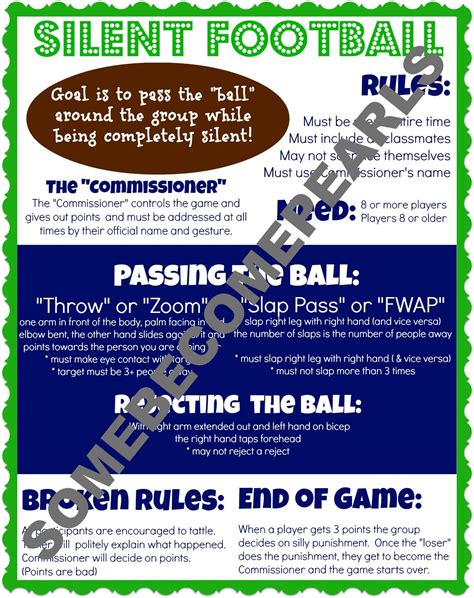Conquer Silent Football: Strategies & Tips for Dominating the Field
Silent football, also known as flag football or touch football, offers a thrilling blend of strategy and athleticism, stripped down to the essence of the game. While the absence of tackling simplifies the physicality, it doesn't diminish the need for sharp tactics and precise execution. This guide provides essential strategies and tips to help you conquer the silent football field and lead your team to victory.
Understanding the Fundamentals: Offense
A successful silent football offense hinges on three key elements: efficient passing, strategic running, and smart play-calling.
Mastering the Art of the Pass
Accurate and timely passes are paramount. Practice different passing techniques – the short, quick pass to move the chains, the long bomb for a big gain, and the lateral pass to avoid pressure. Consider your receivers' strengths: does one excel in short routes while another is a deep threat? Utilize their abilities strategically.
Effective Running Plays
While passing is crucial, a well-balanced offense incorporates effective running plays. Utilize various running techniques, including sweeps, inside runs, and counter plays, to keep the defense guessing. Employ misdirection and fakes to create openings for your runners. A strong running game can set up the pass and wear down the opposing defense.
Strategic Play-Calling
Adaptability is key. Don't stick to a rigid playbook. Analyze the defense's formations and tendencies, and adjust your play-calling accordingly. If the defense is heavily stacked against the run, exploit their weakness with the pass. Similarly, if the defense is vulnerable to deep routes, use them to your advantage. Effective communication with your quarterback is essential.
Defending the Territory: Defense
Defensive strategies in silent football prioritize disruption and preventing big plays.
Covering Receivers
Effective receiver coverage relies on close marking, anticipation, and communication. Understand your responsibilities in zone coverage and execute man-to-man assignments precisely. Practice reacting quickly to different route combinations and maintain proper positioning to prevent receptions.
Pressure, but Controlled
Unlike tackle football, the absence of tackling necessitates a different approach to pressuring the quarterback. Instead of blitzes, focus on quick, controlled rushes aimed at disrupting passing lanes and forcing hurried throws. Employ strategic positioning to cover passing lanes and use your body to shield the quarterback's vision.
Reading the Offense
An astute defense anticipates the offense's next move. Pay close attention to the quarterback's pre-snap movements and formations. Look for tendencies and clues that reveal the likely play. This foreknowledge allows you to better position yourself to make key plays.
People Also Ask: Common Questions & Answers
What are some common silent football rules variations?
Rule variations are common in silent football. Some leagues may have different rules regarding forward passes, the number of downs, and the size of the playing field. Always check the specific rules of the league you're playing in before the game.
What are some essential drills to improve my silent football skills?
Drills focusing on quick passes, agility drills for running backs and receivers, and reaction drills to improve defensive positioning are all extremely valuable. Cone drills, ladder drills, and shuttle runs are examples of useful drills. Always practice as a team to develop synergy.
How can I improve my quarterback skills in silent football?
Practice different throwing techniques, such as overhand, sidearm, and short passes. Master quick release throws, and practice accuracy at various distances. Also, learn to read defenses and make smart decisions under pressure. Practice with different receivers to learn their strengths.
How can I become a better silent football receiver?
Practice running various routes (slants, outs, posts, etc.) and develop precise route-running techniques. Develop strong hand-eye coordination to catch passes consistently, and practice different techniques for catching the ball in different situations. Work on your agility and speed to evade defenders.
What are some strategies for a smaller, less athletic team?
Smaller, less athletic teams can succeed by focusing on highly disciplined play, strategic formations, and deception. Emphasize flawless execution and smart plays over brute strength. Utilize quick passes and creative plays to exploit defensive gaps.
By mastering these strategies and tips, and consistently practicing, you can significantly enhance your silent football game and lead your team to victory. Remember, the key is teamwork, adaptability, and a deep understanding of the game's dynamics.

